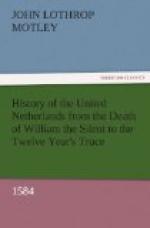The religion of the United Netherlands was Calvinistic. There were also many Anabaptists in the country. The Queen of England hated Anabaptists, Calvinists, and other sectarians, and banished them from her realms on pain of imprisonment and confiscation of property. As firmly opposed as was her father to the supremacy of the Bishop of Rome, she felt much of the paternal reluctance to accept the spirit of the Reformation. Henry Tudor hanged the men who believed in the Pope, and burnt alive those who disbelieved in transubstantiation, auricular confession, and the other ‘Six Articles.’ His daughter, whatever her secret religious convictions, was stanch in her resistance to Rome, and too enlightened a monarch not to see wherein the greatness and glory of England were to be found; but she had no thought of tolerating liberty of conscience. All opposed to the Church of England, whether Papists or Puritans, were denounced as heretics, and as such imprisoned or banished. “To allow churches with contrary rites and ceremonies,” said Elizabeth, “were nothing else but to sow religion out of religion, to distract good men’s minds, to cherish factious men’s humours, to disturb religion and commonwealth, and mingle divine and human things; which were a thing in deed evil, in example worst of all; to our own subjects hurtful, and to themselves—to whom it is granted, neither greatly commodious, nor yet at all safe.”—[Camden] The words were addressed, it is true, to Papists, but there is very little doubt that Anabaptists or any other heretics would have received a similar reply, had they, too, ventured to demand the right of public worship. It may even be said that the Romanists in the earlier days of Elizabeth’s reign fared better than the Calvinists. The Queen neither banished nor imprisoned the Catholics. She did not enter their houses to disturb their private religious ceremonies, or to inquire into their consciences. This was milder treatment than the burning alive, burying alive, hanging, and drowning, which had been dealt out to the English and the Netherland heretics by Philip and by Mary, but it was not the spirit which William the Silent had been wont to manifest in his measures towards Anabaptists and Papists alike. Moreover, the Prince could hardly forget that of the nine thousand four hundred Catholic ecclesiastics who held benefices at the death of Queen Mary, all had renounced the Pope on the accession of Queen Elizabeth, and acknowledged her as the head of the church, saving only one hundred and eighty-nine individuals. In the hearts of the nine thousand two hundred and eleven others, it might be thought perhaps that some tenderness for the religion from which they had so suddenly been converted, might linger, while it could hardly be hoped that they would seek to inculcate in the minds of their flocks or of their sovereign any connivance with the doctrines of Geneva.




